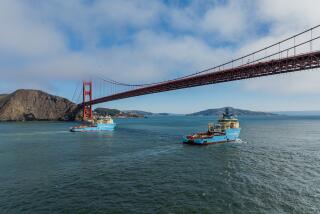Giving Waikiki back its beach
- Share via
HONOLULU — Along the sandy sliver that is Hawaii’s world-famous Waikiki beach, waves sometimes reach all the way across the sand to touch solid land.
At some points, the sparkling beach is only wide enough for two or three beachgoers to lay on the narrow swath between land and ocean.
After years of chronic erosion, a test sand-pumping project is trying to reclaim the iconic beach from offshore without having to truck in new sand from around Oahu, other Hawaiian islands or even other countries.
Scientists say the beach has been gradually shrinking by about 1 foot a year over the last five decades as the Pacific’s rough currents wear away the smooth, peaceful surface.
While the beach still satisfies millions of yearly visitors, it’s barely a sandbox compared with the vast dune-like expanses found half a century ago. If it’s not cared for, Waikiki beach would eventually disappear.
“It used to be big. Now it’s crowded, and everyone is bunched together,” said Honolulu resident Ashley Granados as she sat in a swimsuit alongside the beach where it’s about 20 yards wide. “The water is too close.”
Beach erosion is common around the world, and the usual remedy is to truck in sand, but that hasn’t been done in any major way at Waikiki since the 1970s. Sand had previously imported from Molokai, other areas of Oahu and -- if you believe local legends -- as far away as Australia.
Waikiki, whose beach bares different names as it stretches from near Diamond Head to the public boat harbor, steadily declined for most of the last 30 years. The plan is to dredge 10,000 cubic yards of sand from about half a mile offshore, then pump it underwater back to the beach.
The $425,000 test program gives beach lovers hope that Waikiki could be restored to its original splendor, but officials have said it could cost up to $25 million to repair all of Waikiki’s beach.
Sand pumping has been used at other beaches in the country, but it has rarely been tried in Hawaii before now because of fears over disrupting the delicate ocean floor and a lack of funding.
“Waikiki is probably best known for the fact that it’s a major resort destination with sun, sand and surf,” said Rick Egged, president of the Waikiki Improvement Assn. “The health of Waikiki beach is very central to Hawaii’s image.”
Just a walk across the street from Waikiki’s hotels and shops, the beach periodically widens and narrows. Surfers wade out to catch the waves, paddlers row their canoes, kids build sand castles and others bask in the warmth of the tropical sun.
At the pink stucco Royal Hawaiian Hotel, the beach stops entirely at a concrete wall. Water laps at the wall for several yards before the sand reappears.
Most visitors say they’re still impressed with the legendary beach that is so closely identified with the essence of Hawaii.
“We’re just happy to be here,” said Janet Corey, a tourist from Canada, swimming with her daughters where the beach gets particularly thin. “Maintaining the beach seems to be the right thing to do because that’s why people come here.”
The major cause of Waikiki’s coastal erosion is human development of the shoreline, including the construction of sea walls and the loss of coastal dunes buried by manmade structures, said Chip Fletcher, a University of Hawaii professor and expert in coastal geology.
“We sell Hawaii in the form of thousands of photographs of our beaches every year,” Fletcher said. “If the beaches go away, we have a problem.”
State officials contend the plan to dredge and pump sand is an environmentally friendly solution because it recycles the same sand that was originally part of the beach.
If successful, they say, this project could become a model for replenishing more of Waikiki and other fading island beaches.
Like repainting a house every few years, government officials will need to be vigilant if they want the beach to stay around, Fletcher said. Otherwise, Hawaii could lose part of its identity.
More to Read
Sign up for Essential California
The most important California stories and recommendations in your inbox every morning.
You may occasionally receive promotional content from the Los Angeles Times.













